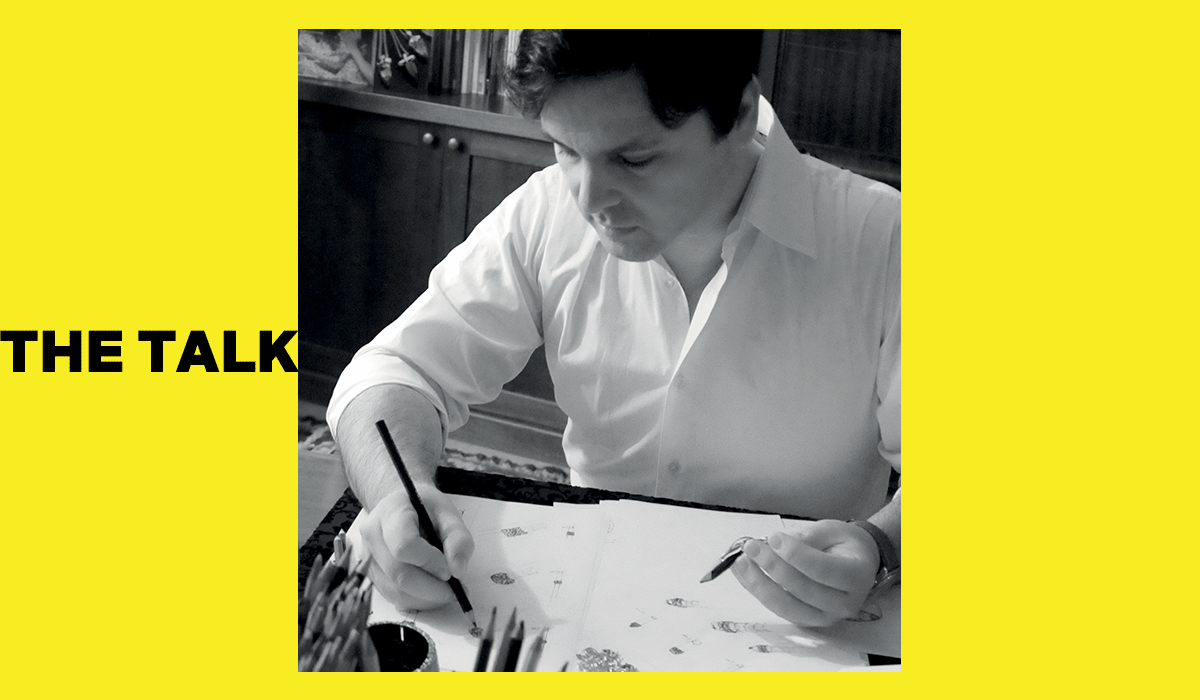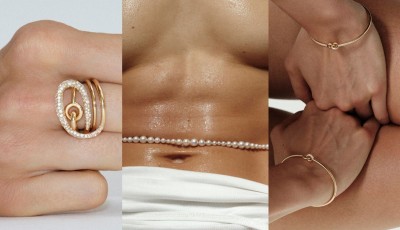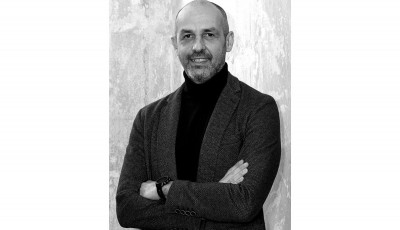THE TALK: The New Challenge is the Final Consumer
A lockdown that did not stop the Gold Art group’s creativity and projects. Fabrizio Falcinelli, Artistic Director of Gold Art, Falcinelli and Tavanti Jewels spoke to us about it
The lockdown was, to some extent, a bearer of new projects. How is your group re-opening business?
In reality, although production was at a lengthy standstill, the creative part was always active. I think the same can be said for more or less everyone. The lockdown gave us time to think over the things that work more and reflect on those that are now working less in view of radically changing markets.
Are you also referring to the price of gold?
Undoubtedly the price of gold will determine how future collections develop. But before taking any decisions on that, I want to wait and see exactly how the market moves. I don’t know what to expect until we get back into the field. Therefore, as yet, we have no idea whether the increase in the price of gold will lead to lowering the weight of jewelry or a reduction in purchases. We have, however, prepared collections with a slightly lighter gold weight. Lines that I had already designed but which will now go into production with some small changes to make them lighter, perhaps on the chain, for example.
The Gold Art group has always mainly focused on exports. The new Tavanti Jewels project, on the other hand, looks to Italy...
That’s right. The Gold Art company, which includes Falcinelli and Tavanti Jewels, is starting to open a series of flagship stores in Italy with Falcinelli collections for jewelry and Tavanti for gold art. All lines designed for and dedicated to the Italian market with two sales points soon to be opened in Venice and an expansion project in Rome, Milan, Porto Cervo… It is a moment that requires a different vision, an enormous challenge that sees us close to the final consumer for the very first time. And, once the flagship stores have opened and become consolidated, the next objective will be multi-brand stores. We have never worked in Italy as brands but we are well known. The flagship stores will act as visiting cards and, during a moment when many are scared, we are challenging the market.
As a creative artist, how do you see this return?
It will certainly be a return that rewards yellow gold. Fashion brought it back into vogue some time ago and consumption continues to follow suit. A metal that has undergone a considerable rebound, especially in bringing back significant volumes even if minimal jewelry is still holding firm.
Let’s go back to the foreign markets. What is the situation on those where you usually do more business?
At the moment, as I said, orders are still blocked in the Middle East as in Asia and America. We are still on standby. We have small orders but we have yet to notice a revival. All the distribution in North and Central Africa, as well as in Iran and Iraq, depends on the goods we have in Dubai, which is the crossroads for shipping metal to the whole world, also thanks to wholesalers that buy for these markets. It is they who decide on moving the goods, we cannot manage it. At a product level, in general African women always look for yellow gold which we contrast with mirror polishing, sandblasting and various shades. Jewelry has to be flashy and large. In Africa, gold has always been an investment factor which is why it is always bought by weight, never for eternity. They often buy it and, after a year, melt it all down and buy new things because they are always willing to spend. They are not interested in small things and it is rare to see a point of light on a woman because jewelry has to follow the look and stand out from the colors of their patterned fabrics.
Instead, how does Asia see a Gold Art jewel?
Well, Asia is a world in itself. To be able to work there, you have to know what to do. It took me a year and a half of collections before I understood what the right product was, and it neither depends on volume nor weight. To sell in Asia, especially in China, first of all you have to know their culture. A purchase is determined by a psychological factor, by historical and popular beliefs. They are extremely superstitious. For example, I learned that, in China, jewelry must never have even one hole because it is said to take money away. Obviously, every area has its own peculiarities. In my journeys, I have always taken notes because sometimes a particular item works while another one doesn’t, but they can’t give you a reason why they prefer one jewel over another. You have to interpret.
While we work with distributors in China, in Burma we do everything directly. There is an enormous difference between the two countries. They want different heaviness, for example. Falcinelli works very well on these markets because we use stones, which they really love and often become an object of cult, such as jade, whose costs are astronomical. As for gold, they don’t want white, much preferring yellow and pink, and items must be small. For sales, I usually prepare a generic collection specifically for Asia and exclusive targeted collections for the more important customers.
A company with 110 employees, well-structured market-targeted production areas, a new marketing department and, above all, innovation. We could say that Gold Art is an authentic hub...
Technology gives you that touch of newness that creativity alone does not offer. We cannot do without technological innovation. Our mirror polishings are the result of these processes. Tavanti Jewels, for example, has collections with the very latest mirror polishings that we don’t use even on Gold Art lines. New ideas are always linked to the material, to the capacity for assembly and to production techniques. For example, we are able to mirror polish almost any geometric shape thanks to the help of particular robots, created by our engineers, whose optic readers can ‘read’ the metal surface and perfectly rub the metal. A work of precision which would not give the same result if done by hand and which, until now, could only be applied on round and oval forms. I would add, however, that the value of a jewel also and mainly lies in its Italianness and that workmanship that manages to ‘put things together’, something that only Italian tailoring knows how to do. I see a lot as I go around the world but something is always missing. Then I look at Italy where creativity is lord, something that is a slightly absent everywhere else. We are number one, but we have to gallop.
A dutiful last question on trade shows. Physical, digital of phygital?
Physical trade shows are still the most effected tool for doing business. As a creative artist, trade shows are fundamental for making the customer understand. Every buyer needs to physically touch the goods. Digital certainly works for the final customer but physicality is essential for wholesalers.
Digital is alright for a one-off but collections need to be seen.
In reality, although production was at a lengthy standstill, the creative part was always active. I think the same can be said for more or less everyone. The lockdown gave us time to think over the things that work more and reflect on those that are now working less in view of radically changing markets.
Are you also referring to the price of gold?
Undoubtedly the price of gold will determine how future collections develop. But before taking any decisions on that, I want to wait and see exactly how the market moves. I don’t know what to expect until we get back into the field. Therefore, as yet, we have no idea whether the increase in the price of gold will lead to lowering the weight of jewelry or a reduction in purchases. We have, however, prepared collections with a slightly lighter gold weight. Lines that I had already designed but which will now go into production with some small changes to make them lighter, perhaps on the chain, for example.
The Gold Art group has always mainly focused on exports. The new Tavanti Jewels project, on the other hand, looks to Italy...
That’s right. The Gold Art company, which includes Falcinelli and Tavanti Jewels, is starting to open a series of flagship stores in Italy with Falcinelli collections for jewelry and Tavanti for gold art. All lines designed for and dedicated to the Italian market with two sales points soon to be opened in Venice and an expansion project in Rome, Milan, Porto Cervo… It is a moment that requires a different vision, an enormous challenge that sees us close to the final consumer for the very first time. And, once the flagship stores have opened and become consolidated, the next objective will be multi-brand stores. We have never worked in Italy as brands but we are well known. The flagship stores will act as visiting cards and, during a moment when many are scared, we are challenging the market.
As a creative artist, how do you see this return?
It will certainly be a return that rewards yellow gold. Fashion brought it back into vogue some time ago and consumption continues to follow suit. A metal that has undergone a considerable rebound, especially in bringing back significant volumes even if minimal jewelry is still holding firm.
Let’s go back to the foreign markets. What is the situation on those where you usually do more business?
At the moment, as I said, orders are still blocked in the Middle East as in Asia and America. We are still on standby. We have small orders but we have yet to notice a revival. All the distribution in North and Central Africa, as well as in Iran and Iraq, depends on the goods we have in Dubai, which is the crossroads for shipping metal to the whole world, also thanks to wholesalers that buy for these markets. It is they who decide on moving the goods, we cannot manage it. At a product level, in general African women always look for yellow gold which we contrast with mirror polishing, sandblasting and various shades. Jewelry has to be flashy and large. In Africa, gold has always been an investment factor which is why it is always bought by weight, never for eternity. They often buy it and, after a year, melt it all down and buy new things because they are always willing to spend. They are not interested in small things and it is rare to see a point of light on a woman because jewelry has to follow the look and stand out from the colors of their patterned fabrics.
Instead, how does Asia see a Gold Art jewel?
Well, Asia is a world in itself. To be able to work there, you have to know what to do. It took me a year and a half of collections before I understood what the right product was, and it neither depends on volume nor weight. To sell in Asia, especially in China, first of all you have to know their culture. A purchase is determined by a psychological factor, by historical and popular beliefs. They are extremely superstitious. For example, I learned that, in China, jewelry must never have even one hole because it is said to take money away. Obviously, every area has its own peculiarities. In my journeys, I have always taken notes because sometimes a particular item works while another one doesn’t, but they can’t give you a reason why they prefer one jewel over another. You have to interpret.
While we work with distributors in China, in Burma we do everything directly. There is an enormous difference between the two countries. They want different heaviness, for example. Falcinelli works very well on these markets because we use stones, which they really love and often become an object of cult, such as jade, whose costs are astronomical. As for gold, they don’t want white, much preferring yellow and pink, and items must be small. For sales, I usually prepare a generic collection specifically for Asia and exclusive targeted collections for the more important customers.
A company with 110 employees, well-structured market-targeted production areas, a new marketing department and, above all, innovation. We could say that Gold Art is an authentic hub...
Technology gives you that touch of newness that creativity alone does not offer. We cannot do without technological innovation. Our mirror polishings are the result of these processes. Tavanti Jewels, for example, has collections with the very latest mirror polishings that we don’t use even on Gold Art lines. New ideas are always linked to the material, to the capacity for assembly and to production techniques. For example, we are able to mirror polish almost any geometric shape thanks to the help of particular robots, created by our engineers, whose optic readers can ‘read’ the metal surface and perfectly rub the metal. A work of precision which would not give the same result if done by hand and which, until now, could only be applied on round and oval forms. I would add, however, that the value of a jewel also and mainly lies in its Italianness and that workmanship that manages to ‘put things together’, something that only Italian tailoring knows how to do. I see a lot as I go around the world but something is always missing. Then I look at Italy where creativity is lord, something that is a slightly absent everywhere else. We are number one, but we have to gallop.
A dutiful last question on trade shows. Physical, digital of phygital?
Physical trade shows are still the most effected tool for doing business. As a creative artist, trade shows are fundamental for making the customer understand. Every buyer needs to physically touch the goods. Digital certainly works for the final customer but physicality is essential for wholesalers.
Digital is alright for a one-off but collections need to be seen.






